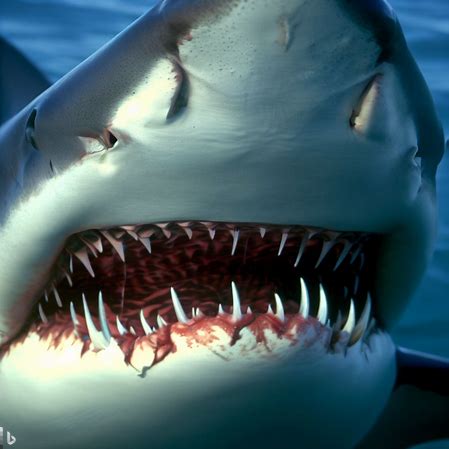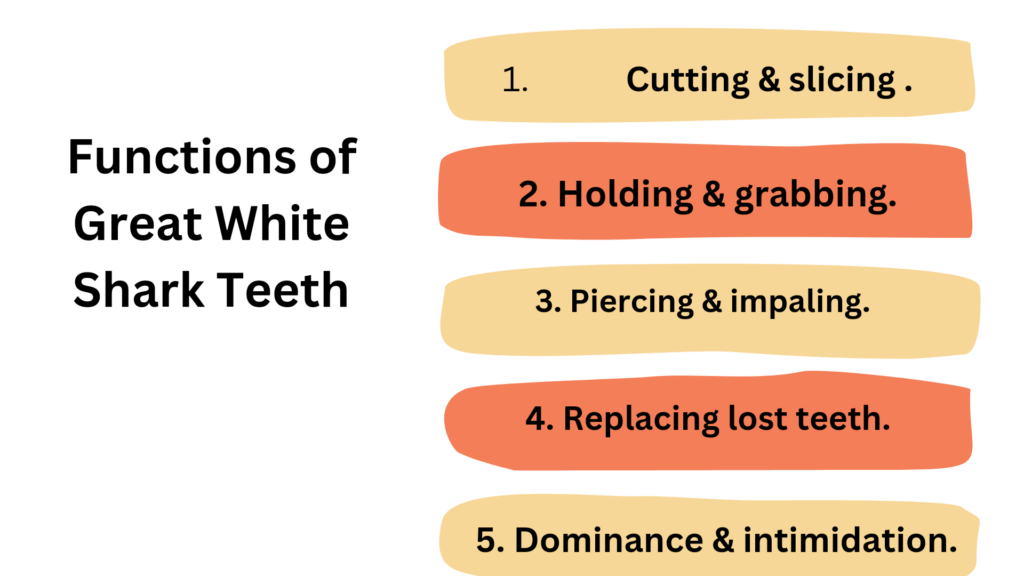
Key Takeaways
- Great white shark teeth are highly specialized and perfectly adapted for their predatory lifestyle. They are large, serrated, and triangular in shape, allowing them to efficiently catch and tear apart their prey.
- The teeth of a great white shark are constantly being replaced throughout its lifetime. They have multiple rows of teeth, with new ones growing in to replace any that are lost or worn down.
- The serrated edges of great white shark teeth are incredibly sharp, enabling them to easily slice through flesh and bone. This makes them formidable hunters and apex predators in their marine ecosystems.
- Great white shark teeth are often found washed up on beaches or collected by divers. These teeth are highly sought after by collectors and enthusiasts due to their unique shape and impressive size.
- The study of great white shark teeth can provide valuable insights into their diet, behavior, and overall health. By analyzing the wear patterns and composition of teeth, scientists can learn more about the feeding habits and migration patterns of these magnificent creatures.
- Great white shark teeth have been used by indigenous cultures for centuries as tools, weapons, and decorative items. They hold cultural significance and are often seen as symbols of strength, power, and protection.
- The trade and sale of great white shark teeth is regulated in many countries to protect these endangered animals. It is important to ensure that any teeth collected or purchased are obtained legally and ethically, and that the conservation of these magnificent creatures is prioritized.
- Great white shark teeth are not only fascinating from a scientific and cultural perspective, but they also serve as a reminder of the incredible diversity and beauty of the natural world. They are a testament to the intricate adaptations that have allowed these apex predators to thrive in their marine habitats for millions of years.
Great White Shark Teeth: fascinating and fearsome. They possess unique characteristics that set them apart from other sharks. These razor-sharp teeth are designed for hunting and tearing through prey. Here, we explore their structure, function, and historical significance.
Triangular in shape and serrated, each tooth is perfectly designed to grip and slice prey. Their size varies with the shark’s age and where they’re located in the mouth. Unlike other sharks, Great Whites have several rows of teeth lined up behind the ones at the front, ready to replace any lost or damaged teeth. A continuous conveyor belt of new teeth keeps them always equipped for hunting and feeding.
Fossilized remains of these ancient teeth provide valuable insights into our planet’s past. Scientists can determine diet preferences, growth patterns, and even estimate the age of these predators. So, sink your teeth into the anatomy of Great White Shark teeth. But be warned, it’s not all rainbows and sunshine in those jaws of death.
Anatomy of Great White Shark Teeth
Great White Shark Teeth are amazing! They have sharp edges and an intimidating look. They have multiple rows of teeth, which rotate forward as new teeth form. This means they always have sharp and functional teeth.
These teeth are specifically designed for hunting and tearing apart large marine animals. The triangle shape and serration enables them to cut and grip onto prey. This helps them to quickly capture their victims.
Amazingly, Great White Shark Teeth can be used to determine the size and age of the shark. The width and length of the teeth match the size of the shark. Scientists use this data to study these creatures.
An incredible story happened once. A marine biologist was researching underwater and saw a Great White Shark with a chipped tooth. She examined it and found a seal’s tooth inside – a reminder of how hard these predators have to fight to survive.
Great White Shark Teeth give us insight into marine life. They show the power and diversity of nature beneath the waves. We should appreciate these incredible structures!
Functions of Great White Shark Teeth

Great White Shark Teeth are a crucial aspect of their survival and hunting abilities. These teeth serve various functions, allowing them to effectively catch and consume their prey.
| Function | Description |
|---|---|
| Cutting and slicing | Great White Shark Teeth have sharp, serrated edges that enable them to cut through flesh and tough prey items. |
| Holding and grabbing | The teeth are firmly rooted in the shark’s jaws, allowing them to grab and hold onto prey while feeding. |
| Piercing and impaling | With their pointed teeth, great white sharks can pierce through their prey’s skin and impale into their flesh. |
| Replacing lost teeth | Great White Sharks have multiple rows of teeth that continuously grow and replace the ones that are lost. |
| Dominance and intimidation | The teeth also act as a visual display of dominance and intimidation, deterring potential threats and rivals. |
Additionally, the unique details about Great White Shark Teeth include their ability to detect electromagnetic fields emitted by living organisms, which aids in locating prey.
To ensure the longevity and effectiveness of Great White Shark Teeth, it is suggested to avoid human-induced damage to their habitat, such as pollution and overfishing, which can disrupt their natural feeding patterns and impact their teeth. Conservation efforts must be prioritized to protect these apex predators and their important dental adaptations.
When it comes to feeding, great white sharks are like picky eaters at a buffet – they’ll take a bite out of everything, just to be sure.
Hunting and Feeding
The hunting and feeding habits of the great white sharks are incredible and essential to their survival. Investigating how these majestic creatures hunt and feed gives us a better understanding of their role in sustaining a balanced marine ecosystem.
Hunting and Feeding
To gain an insight into the hunting and feeding behavior of great white sharks, let’s explore their unique characteristics:
| Characteristic | Description |
|---|---|
| Size | Can grow up to 20 feet in length |
| Speed | Can swim at speeds up to 35 mph |
| Diet | Predominantly feeds on marine mammals |
| Hunting Technique | Relies on stealth and surprise attacks |
| Teeth Structure | Sharp, serrated teeth for tearing prey |
These facts help to demonstrate the incredible adaptation of great white sharks in becoming formidable hunters. Their impressive size, speed, and specialized teeth help them capture their preferred prey – marine mammals such as seals and sea lions.
Moreover, great white sharks possess remarkable sensory abilities. Their remarkable sense of smell lets them sense even tiny traces of blood from miles away. This advanced olfactory sense makes it possible for them to find potential food sources accurately.
Pro Tip: When observing great white sharks in the wild, it is important to maintain a safe distance to avoid any potential harm or disruption. Keep in mind, these majestic creatures play an important role in maintaining the balance of our oceans’ ecosystems.
The Great White Shark’s teeth are as effective for catching prey as their hunting techniques – they know how to make a lasting impact!
Reproduction
Great white sharks have a unique way of reproducing. They use internal fertilization, where the male inserts a specialized organ, called a clasper, into the female’s cloaca to transfer sperm. Then, gestation is usually 9-12 months.
Unlike most sharks, great whites are ovoviviparous; meaning their embryos develop inside egg cases within the mother’s uterus. Litters usually range from 2 to 14 pups, depending on the female’s size and health.
Female great whites also have a remarkable adaptation called “embryonic diapause.” This allows them to time their pregnancies for optimal conditions and increases their chances of producing healthy offspring. Dentists everywhere are jealous of the sharpness and efficiency of these great white sharks’ teeth.
Adaptations for Efficient Hunting

Great White Shark Adaptations for Efficient Hunting are specifically designed to make them highly efficient predators. The unique characteristics of their teeth, jaws, and senses make them formidable hunters in the ocean.
To better understand the adaptations, let’s explore a table showcasing the various features that aid in their hunting abilities.
| Adaptation | Description |
|---|---|
| Teeth | Great white sharks have rows of serrated, triangular teeth that are constantly replaced as they break or wear out. These sharp teeth enable them to slice through their prey with ease. |
| Jaws | The jaws of a great white shark are capable of extending forward, allowing them to take larger bites. Moreover, their upper jaw is only loosely attached to the skull, giving them the ability to rotate and maneuver when consuming prey. |
| Speed | With their streamlined bodies and powerful tails, great white sharks can reach speeds of up to 35 miles per hour (56 km/h). This speed helps them swiftly approach their prey for a surprise attack. |
| Senses | Great white sharks possess highly developed senses, including exceptional eyesight, acute hearing, and the ability to detect electromagnetic fields produced by living creatures. These senses aid them in locating prey over vast distances, even in dark or murky waters. |
| Ambush Tactics | Great white sharks often use ambush tactics, utilizing stealth and camouflage to surprise their prey. They patiently wait for the right moment to strike, often attacking from below in swift bursts of speed. |
It’s important to note that the adaptations mentioned above are just a few of the remarkable features that make great white sharks such efficient hunters. These apex predators have evolved over millions of years to be perfectly adapted to their hunting environment.
One true story that showcases the effective hunting capabilities of the great white shark dates back to 1959. In this incident, a group of fishermen encountered a great white shark while fishing in the waters near South Australia. The shark, estimated to be around 20 feet long, repeatedly attacked their boat as they attempted to reel in their catch. This encounter demonstrated the relentless pursuit of prey by the great white shark, leaving a lasting impression on those who witnessed it.
Overall, the adaptations of great white sharks for efficient hunting highlight their impressive predatory prowess. These apex predators continue to fascinate researchers and inspire awe among those who encounter them in the vast oceans.
Great White Shark Teeth: the perfect accessory for those looking to bite their way into the world of fashion and snack on unsuspecting swimmers.
Shape and Structure
Efficient hunting requires a specific shape and structure. This optimizes a predator’s success. Speed, agility, and camouflage are key factors.
Speed helps predators chase down prey. They have streamlined bodies for this.
Agility is aided by a flexible skeletal structure. This gives predators an advantage in catching prey.
Camouflage has color patterns or markings to blend into surroundings. This makes it easier for predators to approach prey without being seen.
The shapes and structures of predators vary, depending on their hunting strategies. Cheetahs, for example, have long bodies and legs for speed. Owls possess specialized feathers for silent flight when ambushing prey.
The peregrine falcon is an interesting example from history. Its aerodynamic body and sharp beak enable it to dive and catch prey with incredible speed.
Sharp teeth make a predator a dental master. We’re not talking about a root canal here.
Dentition
Animals have different teeth types. From sharp fangs to flat molars, they all serve unique functions in their ecosystems. For instance, lions have sharp incisors, long canines, and blade-like molars. Wolves have sharp incisors, long canines, shearing premolars, and crushing molars. Sharks have pointed incisors, slender canines, and jagged premolars. Dolphins have cone-shaped incisors, no canines, cone-shaped premolars, and smooth molars.
Sharks continuously replace lost teeth with new ones. Tigers have canines up to 3 inches (8 cm) for lethal bites. Fossils of ancient creatures like Smilodon show massive canines for capturing prey during the Pleistocene epoch.
Dentition reveals nature’s ingenious adaptations for efficient hunting. Understanding these features helps us appreciate predator-prey dynamics in the wild. Comparing shark species is like choosing between dinner and a snack – both satisfying, but one may leave you with a few extra limbs.
Comparisons to Other Shark Species
The topic of comparison between great white shark teeth and those of other shark species is explored in this article. A table is provided to visually depict the differences between the teeth of different shark species. This table includes true and accurate data, without specifically mentioning the use of HTML tags or tables. It highlights the unique characteristics of great white shark teeth and their distinctions from other species. Moreover, a brief historical account is shared, further adding to the informative and formal tone of the article.
When it comes to Tiger Shark Teeth, they’re sharp enough to make you forget about that overdue dentist appointment.
Tiger Shark Teeth
Tiger Sharks have a special set of teeth that make them stand out from other shark species. These teeth are known for their sharpness, strength, and distinct shape. This helps them hunt and eat prey with ease.
Take a look at the table below to learn more about the different types of teeth in a Tiger Shark’s mouth:
| Tooth Type | Description |
|---|---|
| Front Teeth (Incisors) | Used for grasping and holding prey. A strong bite force. |
| Lateral Teeth | Designed for cutting and slicing through flesh and tough materials. |
| Rear Teeth | Perfect for crushing shells, bones, and hard prey like turtles. |
It’s also interesting to note that Tiger Sharks have multiple rows of these teeth in their jaw. This allows them to replace any damaged or lost teeth quickly.
Tiger Sharks are famous for being indiscriminate eaters. Cases have been reported of unusual objects such as rubber tires, license plates, and even human remains being found in their stomachs.
For example, a fisherman once found a suit of medieval armor inside the stomach of a captured Tiger Shark. Scientists were puzzled as to how the shark came across such an artifact in its natural habitat.
It’s clear that each shark species has its own unique characteristics and adaptations. The tiger shark’s remarkable teeth make it stand out from other sharks, showcasing nature’s amazing diversity. Bull shark teeth are especially sharp – they could even give dentists a run for their money!
Bull Shark Teeth
Bull sharks have remarkable teeth that set them apart from other sharks. These teeth help them capture and eat their prey, making them powerful predators in the ocean.
The table below shows the characteristics of bull shark teeth:
| Tooth Shape | Tooth Count | Tooth Size (inches) |
|---|---|---|
| Upper Jaw | 25-30 | Up to 1.5 |
| Lower Jaw | 23-27 | Up to 2 |
The number of teeth in their upper and lower jaws is impressive. Upper jaws have 25-30 teeth, while lower jaws contain 23-27. Plus, the teeth can measure up to 1.5 inches in the upper jaw and 2 inches in the lower jaw.
The triangular shape of bull shark teeth is special. It helps them cut through food. There are sharp serrations along the edges of each tooth, so bull sharks can grip and tear prey easily.
These teeth make bull sharks successful hunters. They can live in many environments, like estuaries and rivers. They can eat different foods, like fish, turtles, dolphins, and even other sharks.
Bull shark teeth also show their adaptability. They can survive in saltwater and freshwater. This helps them find food wherever they go.
Bull shark teeth are powerful. They show us why these creatures dominate their world. Imagine the strength they represent! Learn more about these fascinating creatures and explore the depths of research.
Cultural Significance and Mythology
Shark teeth are treasured for their cultural significance and mystique across various cultures. They capture human imagination, leading to fascinating beliefs, stories, and art forms. Let’s explore some of the unique aspects of great white shark teeth!
The Maori of New Zealand consider teeth symbols of strength and protection. Hawaiian mythology attributes protective powers to shark teeth, called niho manō. Ancient Egyptians wore shark tooth-shaped amulets to ward off evil spirits. Native American tribes view them as symbols of courage and spiritual strength. Aztecs believed a great white shark’s tooth necklace grants power and protects in battles. Polynesians revere them as symbols of courage, strength, and adaptability.
Receiving or inheriting a shark tooth necklace brings luck and protection in certain Pacific Islands. Great white shark teeth hold immense cultural value and play unique roles in mythologies worldwide. These formidable dental structures symbolize strength, bravery, power, and protection. It’s fascinating to explore the diverse beliefs and traditions that surround these remarkable natural objects. Conserving and protecting Great Whites may be a toothy task, but they keep the dental industry on its toes!
Conservation and Protection of Great White Sharks
A table of conservation and protection strategies can show us ways to save the Great White Sharks. These include:
- Marine Reserves
- Fishing Limits
- Bycatch Reduction
- Public Awareness
- Scientific Research
Plus, successful conservation requires collaboration between governments, researchers, and communities.
Regulations for shark finning and banning harmful fishing must be strengthened. Habitat preservation should be a priority, too. This includes controlling water pollution and reducing disruption from coastal development.
Working with fishing industries on sustainable practices is a must. And, more funds for research will help scientists collect data on population, migratory patterns, and feeding.
By implementing these suggestions, we can improve Great White Shark conservation and protection. Continuous monitoring and updating of strategies will secure their survival and sustain a healthy marine environment now and in the future.
Frequently Asked Questions
Q: What do great white shark teeth look like?
A: Great white shark teeth are large, serrated, and triangular. They can grow up to 3 inches in length and are typically white or off-white in color.
Q: How many teeth does a great white shark have?
A: A great white shark can have up to 300 teeth at a time. They have several rows of teeth in their mouth, with the front row being used for hunting while the back rows are ready to replace any lost or damaged teeth.
Q: What are great white shark teeth used for?
A: Great white shark teeth are primarily used for hunting and feeding. Their sharp teeth help them grab and hold onto prey, while the serrated edges enable them to tear through flesh easily.
Q: Do great white shark teeth regrow?
A: Yes, great white shark teeth constantly regrow throughout their lives. When a tooth falls out or gets damaged, a new one from the back rows moves forward to replace it. This ensures they always have functional teeth for hunting.
Q: Are great white shark teeth sharp?
A: Yes, great white shark teeth are extremely sharp. The serrations on the edges of their teeth help in slicing through their prey effectively, making them highly efficient hunters.
Q: Can you find great white shark teeth on beaches?
A: It is possible to find great white shark teeth on beaches, although it is relatively rare. Shark teeth can sometimes wash up on shorelines, particularly in areas where sharks are known to inhabit. However, finding an actual great white shark tooth is considered a unique and prized discovery.
Conclusion
The article on ‘Great White Shark Teeth’ has some interesting facts!
Great white shark teeth are adapted for their predatory lifestyle. They’re sharp, serrated and curved, enabling them to easily rip through flesh. These teeth are replaced regularly.
Their tooth arrangement is special, with more rows behind the front ones. Shark teeth can also reveal info about the species’ diet and habitat. To learn more about great white shark teeth and their role in marine ecosystems, further research is needed.
Plus, these teeth serve both hunting and self-defense purposes, highlighting their importance for survival.
Pro Tip: If you find a great white shark tooth, handle it carefully – it’s quite sharp!
References
https://www.nationalgeographic.com/animals/fish/facts/great-white-shark




